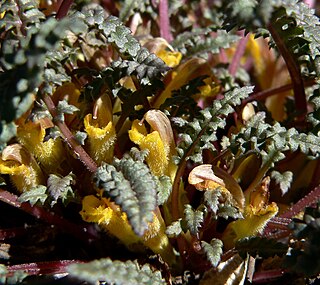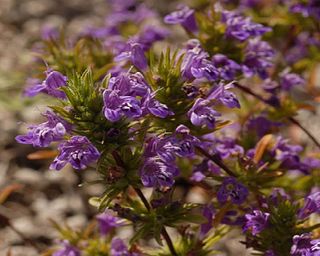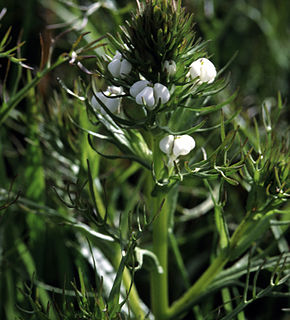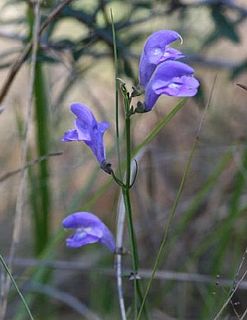
Triphysaria is a genus of five plants in the family Orobanchaceae which are known generally as owl's-clovers. This genus is closely related to the genera Castilleja and Orthocarpus. Triphysaria are native to western North America, including a species endemic to California.

Eucrypta micrantha is a species of flowering plant in the waterleaf family known by the common name dainty desert hideseed.
Lessingia virgata is a species of flowering plant in the family Asteraceae known by the common name wand lessingia. It is endemic to California, where it is known from the eastern side of the Central Valley and adjacent Sierra Nevada foothills. It is a woolly, glandular annual herb growing up to about 60 centimeters tall with slender, spreading branches. The upper leaves are no more than a centimeter long, while the lower ones are longer and sometimes divided into lobes or teeth. The flower heads appear singly in leaf axils, each lined with purple-tipped, glandular, woolly phyllaries. The head is discoid, containing no ray florets but a few tubular light lavender to nearly white disc florets with long, narrow lobes. The fruit is an achene with a whitish pappus on top.
Diplacus pulchellus is an uncommon species of monkeyflower known by the common name yellowlip pansy monkeyflower. It was formerly known as Mimulus pulchellus.
Erythranthe purpurea is a species of monkeyflower known by the common name little purple monkeyflower. It was formerly known as Mimulus purpureus.
Nemacladus interior is a species of flowering plant in the bellflower family known by the common name Sierra threadplant. It is native to the Sierra Nevada of California, and it is known from Oregon as well. It grows in mountain forest habitat. It is an annual herb producing a stiff upright purple-brown stem up to about 25 centimeters tall. Small toothed oval leaves 1 to 2 centimeters long occur at the base of the plant. The inflorescence is a zigzagging series of branches bearing occasional flowers on thin pedicels. There is a single tiny bract at the base of each pedicel. The flower is a few millimeters long. It has five triangular sepals and five corolla lobes, three lobes on the upper lip and two on the lower. The corolla is white to pale purple or pink with a thin red band and yellow spot at the base of each lobe.

Orthocarpus cuspidatus is a species of flowering plant in the broomrape family known by the common names Copeland's owl's clover, Siskiyou Mountains orthocarpus, and toothed owl's-clover. It is native to mountain and plateau habitat in Oregon, California, and Nevada. It is an annual herb producing a slender, glandular, hairy, purple-green stem up to about 40 centimeters tall. The narrow leaves are up to 5 centimeters long, the upper ones deeply divided into three linear lobes. The inflorescence is a dense cylindrical spike of wide, oval green bracts with pinkish points. The flowers emerge from between the bracts. Each purple-pink flower is fuzzy in texture and club-shaped, the lower lip an expanded pouch and the upper lip a narrow, straight beak.

Orthocarpus luteus is a species of flowering plant in the broomrape family known by the common name yellow owl's-clover. It is native to much of western and central North America, where it grows in many types of plateau, grassland, and mountain habitat.
Orthocarpus pachystachyus is a rare species of flowering plant in the broomrape family known by the common names Shasta owl's-clover and Shasta orthocarpus. It is endemic to central Siskiyou County, California, where it is so rarely seen it was thought to be extinct until 1996, when eight individuals were located. The plant grows in an isolated wilderness but since it apparently only occurs on one single hillside it is considered very vulnerable to extinction.

Pedicularis centranthera is a species of flowering plant in the family Orobanchaceae known by the common names dwarf lousewort and Great Basin lousewort. It is native to the western United States from eastern Oregon and California to Colorado and New Mexico, where it grows in sagebrush and other basin and plateau habitat. It is a perennial herb producing several short stems a few centimeters tall from a basal caudex. The leaves are up to 20 centimeters long, lance-shaped and divided into many overlapping toothed, wrinkled, or fringed lobes. The inflorescence is a short raceme bearing many long, protruding, club-shaped flowers. Each flower may exceed 4 centimeters in length and is white or pale purple with dark purple tips on the wide ends of its upper and lower lips. The sepals of the flowers are shorter and hairy. The fruit is a capsule around centimeter long containing seeds with netlike surfaces.

Pedicularis racemosa is a species of flowering plant in the family Orobanchaceae known by the common names sickletop lousewort and leafy lousewort. It is native to western North America, where it grows in coniferous forests. This is a perennial herb producing several stems up to 80 centimetres (31 in) tall, greenish to dark red in color. The leaves are up to 10 centimetres (4 in) long, linear in shape and lined with teeth. The inflorescence is a small raceme of flowers occupying the top of the stem. Each white to light purple or yellow flower is up to 1.6 centimetres long and is divided into a curved or coiled beak-like upper lip and a wide three-lobed lower lip. The fruit is a capsule over a centimeter in length containing smooth seeds.

Pedicularis semibarbata, known by the common name pinewoods lousewort, is a species of flowering plant in the family Orobanchaceae.

Pogogyne nudiuscula is a rare species of flowering plant in the mint family known by the common name Otay mesa mint. It is native to southern San Diego County, California, where it is known only from Otay Mesa near the border with Baja California. It was identified on land south of the Mexican border, but these occurrences have probably been extirpated. It is now known from seven vernal pool complexes just north of the border, and it is a federally listed endangered species of the United States.
Streptanthus farnsworthianus is an uncommon species of flowering plant in the mustard family known by the common name Farnsworth's jewelflower. It is endemic to California, where it is limited to the woodlands of the Sierra Nevada foothills. It is an annual herb producing a hairless, waxy, purple or purple-tinged stem up to half a meter tall or more. The ephemeral basal leaves have blades up to 15 centimeters long which are each divided into several narrow lobes or leaflets. Leaves higher on the stem have purple lance-shaped blades that generally clasp the stem at their bases. Flowers occur at intervals along the upper stem with one or two leaflike purple bracts at the base of the raceme. Each flower has an urn-shaped calyx of purple sepals up to a centimeter long. Curling purple-veined white petals emerge from the tip of the calyx. The fruit is a straight or curving silique up to 12 centimeters long.

Triphysaria eriantha is a species of flowering plant in the family Orobanchaceae, known by the common names johnny-tuck and butter-and-eggs.

Triphysaria floribunda is a rare species of flowering plant in the family Orobanchaceae known by the common name San Francisco owl's-clover. It is endemic to California, where it is known only from the San Francisco Bay Area. It is limited to coastal regions of Marin, San Francisco, and San Mateo Counties, where it occurs in coastal prairie habitats, sometimes on serpentine soils.

Triphysaria pusilla is a species of flowering plant in the family Orobanchaceae known by the common name dwarf owl's-clover.

Triphysaria versicolor is a species of flowering plant in the family Orobanchaceae known by the common name yellowbeak owl's-clover.

Scutellaria floridana, the Florida skullcap, is a rare species of flowering plant. It is endemic to Florida in the United States, where it is known only from the Florida Panhandle. It is threatened by a number of human activities and its small population sizes make it vulnerable. It is a federally listed threatened species.

Penstemon eriantherus is a species of flowering plant in the plantain family known by the common names fuzzytongue penstemon and crested beardtongue. It is native to western North America, where it occurs in western Canada and the northwestern and north-central United States.













